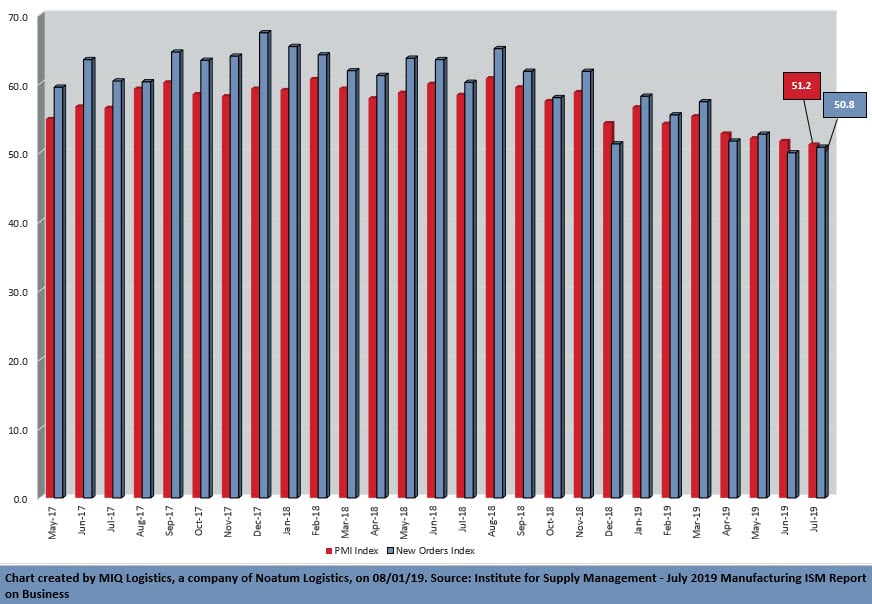Source: Institute for Supply Management, August 1, 2019
Economic activity in the manufacturing sector expanded in July, and the overall economy grew for the 123rd consecutive month, say the nation’s supply executives in the latest Manufacturing ISM® Report On Business®.

The report was issued today by Timothy R. Fiore, CPSM, C.P.M., Chair of the Institute for Supply Management® (ISM®) Manufacturing Business Survey Committee: “The July PMI® registered 51.2 percent, a decrease of 0.5 percentage point from the June reading of 51.7 percent. The New Orders Index registered 50.8 percent, an increase of 0.8 percentage point from the June reading of 50 percent. The Production Index registered 50.8 percent, a 3.3-percentage point decrease compared to the June reading of 54.1 percent. The Employment Index registered 51.7 percent, a decrease of 2.8 percentage points from the June reading of 54.5 percent. The Supplier Deliveries Index registered 53.3 percent, a 2.6-percentage point increase from the June reading of 50.7 percent. The Inventories Index registered 49.5 percent, an increase of 0.4 percentage point from the June reading of 49.1 percent. The Prices Index registered 45.1 percent, a 2.8-percentage point decrease from the June reading of 47.9 percent.
“Comments from the panel reflect continued expanding business strength, but at soft levels. July was the fourth straight month of slowing PMI® expansion. Demand expansion resumed, with the New Orders Index recording marginal growth, the Customers’ Inventories Index entering “about right” territory, and the Backlog of Orders Index contracting for the third straight month, at stronger levels compared to prior months. New export orders also contracted. Consumption (measured by the Production and Employment indexes) continued to expand, but at lower levels. This resulted in a combined decrease of 6.1 percentage points to the PMI® calculation due to minimal new-order growth, backlog contraction and customer-inventory gains. Inputs — expressed as supplier deliveries, inventories and imports — were lower this month, due to inventory tightening for the second straight month and continued slower supplier deliveries, resulting in a combined 3.0-percentage point improvement in the Supplier Deliveries and Inventories indexes. Imports and new export orders contracted. Overall, inputs indicate (1) supply chains are responding marginally slower and (2) supply managers are closely matching inventories to new orders. Prices contracted for the second consecutive month, indicating lower overall systemic demand.
“Respondents expressed less concern about U.S.-China trade turbulence, but trade remains a significant issue. More respondents noted supply chain adjustments as a result of moving manufacturing from China. Overall, sentiment this month is evenly mixed,” says Fiore.
Of the 18 manufacturing industries, nine reported growth in July, in the following order: Wood Products; Printing & Related Support Activities; Furniture & Related Products; Food, Beverage & Tobacco Products; Plastics & Rubber Products; Computer & Electronic Products; Textile Mills; Petroleum & Coal Products; and Chemical Products. The nine industries reporting contraction in July — in the following order — are: Apparel, Leather & Allied Products; Fabricated Metal Products; Primary Metals; Nonmetallic Mineral Products; Transportation Equipment; Paper Products; Miscellaneous Manufacturing; Electrical Equipment, Appliances & Components; and Machinery.
Click here to access the entire release from the Institute for Supply Management website.
